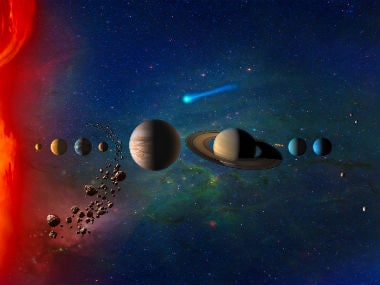The orbits of planets in our **solar system** are expanding as the Sun ages and loses its gravitational grip, say scientists who have observed changes in the trajectory of Mercury to measure the mass loss of our star . [caption id=“attachment_4276249” align=“alignleft” width=“380”]  Representational image. NASA.[/caption] The new values improve upon earlier predictions by reducing the amount of uncertainty. That is especially important for the rate of solar mass loss because it is related to the stability of G, the gravitational constant, researchers said. Although G is considered a fixed number, whether it is really constant is still a fundamental question in physics. “Mercury is the perfect test object for these experiments because it is so sensitive to the gravitational effect and activity of the Sun,” said Antonio Genova, a researcher at Massachusetts Institute of Technology (MIT) in the US. The study, published in the journal Nature Communications, began by improving Mercury’s charted ephemeris, the roadmap of the planet’s position in our sky over time. For that, the team drew on radio tracking data that monitored the location of NASA’s MESSENGER spacecraft while the mission was active. The scientists worked backwards, analysing subtle changes in Mercury’s motion as a way of learning about the Sun and how its physical parameters influence the planet’s orbit. For centuries, scientists have studied Mercury’s motion, paying particular attention to its perihelion, or the closest point to the Sun during its orbit. Observations long ago revealed that the perihelion shifts over time, called precession. Although the gravitational tugs of other planets account for most of Mercury’s precession, they do not account for all of it. The second-largest contribution comes from the warping of space-time around the Sun because of the star’s own gravity, which is covered by Einstein’s theory of general relativity. Other, much smaller contributions to Mercury’s precession, are attributed to the Sun’s interior structure and dynamics. One of those is the Sun’s oblateness, a measure of how much it bulges at the middle, its own version of a “spare tire” around the waist, rather than being a perfect sphere. The researchers obtained an improved estimate of oblateness that is consistent with other types of studies. The researchers were able to separate some of the solar parameters from the relativistic effects, something not accomplished by earlier studies that relied on ephemeris data. The team developed a novel technique that simultaneously estimated and integrated the orbits of both MESSENGER and Mercury, leading to a comprehensive solution that includes quantities related to the evolution of Sun’s interior and to relativistic effects. “We’re addressing long-standing and very important questions both in fundamental physics and solar science by using a planetary-science approach,” said Erwan Mazarico, a geophysicist at NASA’s Goddard Space Flight Center in the US. “By coming at these problems from a different perspective, we can gain more confidence in the numbers, and we can learn more about the interplay between the Sun and the planets,” said Mazarico. The new value is slightly lower than earlier predictions but has less uncertainty. That made it possible for the team to improve the stability of G by a factor of 10, compared to values derived from studies of the motion of the Moon.
The study, published in Nature Communications, began by improving Mercury’s charted ephemeris, the roadmap of the planet’s position in our sky over time.
Advertisement
End of Article


)
)
)
)
)
)
)
)
)



